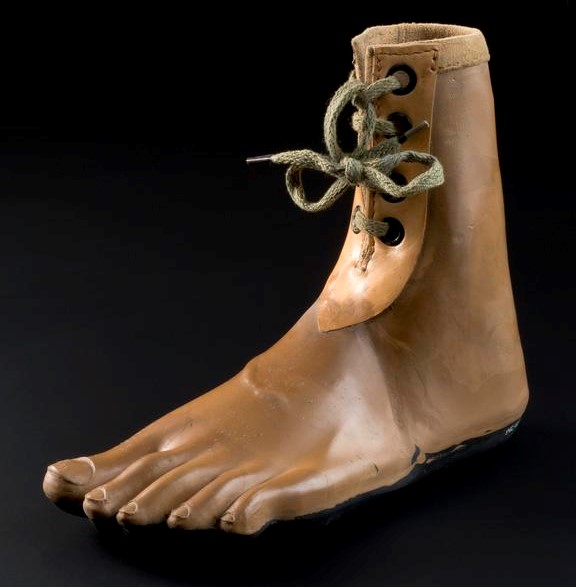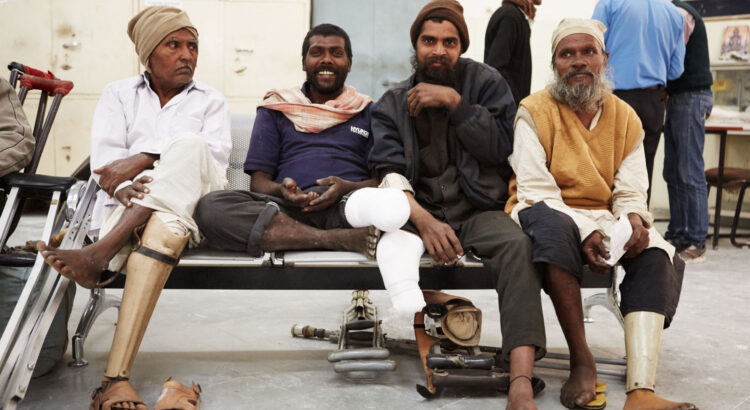Western medicine and science has been responsible for the saving and improving the lives of millions of people all around the world. The successes of Western medicine have led it to be viewed, at least here in the Western world, as superior to other forms of medicine and the only one to be practiced. But this view has obscured us to the contributions from other parts of the world, that the West can learn from. One example of such a contribution can be found in the new permanent exhibition of the Science Museum in London: The Jaipur Foot.

The Jaipur Foot is not a foot … not a foot alone … it has become an outlook, a way of looking at the patient both within the world of medicine and in terms of her life beyond the hospital
Dr. P.K. Sethi, 1986.
On display the Science Museum’s new permanent exhibition ‘Medicine: the Wellcome Galleries’ is one example of a so-called Jaipur Foot. Together with over 3000 other objects it is part of the ‘most significant medical collections in the world.’ At first glance, it may seem like a fairly rudimentary prosthesis, made out of rubber, wood and aluminum. So then what makes this piece so special to the world of medicine?
It is precisely this rudimentary, or better put, simplified nature of this piece of technology that makes it so significant. The Jaipur Foot is a prosthesis developed for below the knee amputations. The one depicted above was specifically made for an Indian patient who underwent a so-called Syme’s amputation, where the foot is amputated through the ankle joint. This specific example highlights the success of the Jaipur Foot, and the significance to medicine, for it is a flexible design that is created from readily available and cheap materials. This makes the Jaipur Foot an affordable prosthesis for many people in the Global South, like in India where it was conceived.

The Jaipur Foot was originally developed in the city of Jaipur, India in 1968 by Dr. Pramod Karan Sethi, an orthopedic surgeon, and Ramachandra Sharma, an artist and artisan who is better known as Masterji. Sethi was working at the Sawai Mansingh Medical College in Jaipur, where he was helping orthopedic patients. While working there he encountered many problems with the prostheses that were available at the time. The one’s that were available were all developed in the Western world, and were incompatible to Sethi’s patients for several reasons. Many of them were made out of materials such as carbon fibre, making the prostheses cost thousands of dollars, meaning that only the wealthiest of patients could afford them. Furthermore, there was also a cultural mismatch. In India and many other countries in Asia, Africa, and South America, there is a ‘barefoot culture’, where people work, sit, eat and sleep on the floor. Farmers also work in waterfilled rice fields. Western prostheses like the SACH (Solid Ankle Cushioned Heel) Foot however, require the wearing of a shoe over it.
At the hospital Sethi met Masterji, and together they developed an indigenous alternative prosthesis. With only basic artisan tools they developed the Jaipur Foot, made out of a rubber core, with a wooden ankle and an aluminum shank, wrapped in a layer of vulcanized rubber. In 45 minutes they could develop a prosthesis that could last up to five years, and would only cos about $45 dollars to produce. Furthermore, their Jaipur Foot was much more suited to the environment of India. The vulcanized rubber made the foot waterproof, and the rubber core allowed for much greater mobility, allowing the patients to squat and sit cross-legged, and therefore work on the floor. A 2004 report (link) of the International Society of Prosthetics and Orthotics (ISPO) found that the Jaipur Foot was technically much better than the SACH Foot that it competed with.

© The Board of Trustees of the Science Museum, London.
The second reason why the Jaipur Foot took of was because of the Soviet invasion of Afghanistan in the 80s. Out of several different options, the International Red Cross chose the Jaipur Foot as the cheapest and most cost-effective prosthesis for victims of landmines. Nowadays, over one and a half million people have benefited from the Jaipur Foot.
Because of the successes of the Jaipur Foot, Dr. Sethi was awarded with the Magsaysay award in 1981, also known as the ‘Asian Noble Prize.’ Time magazine also hailed the Jaipur Foot as one of the greatest inventions of the 20th century in a 1997 article.
To bring attention to the successes of the Jaipur Foot, the Science Museum first collected the object together with a few others for their exhibition ‘Illuminating India: 5000 years of Science and Innovation’, which ran from October 2017 until April 2018, afterwards the Jaipur Foot of the Syme’s amputee got its spot in the permanent exhibition because of its sheer significance.
Jorik de Groot
Further Information:
Article by Rakesh Bhargava ‘The Jaipur Foot and the “Jaipur Prosthesis’ in the Indian Journal of Orthopaedics: https://www.ncbi.nlm.nih.gov/pmc/articles/PMC6394196/
blog written by the Science Museum: https://blog.sciencemuseum.org.uk/jaipur-foot-the-low-cost-prosthetic-that-revolutionised-medical-care-in-india-and-beyond/
The webiste of the BMVSS charity: https://www.jaipurfoot.
Time Magazine article: https://content.time.com/time/subscriber/article/0,33009,987107,00.html
